Ever had that feeling where you’re staring at a spreadsheet, mindlessly copying and pasting names, emails, and phone numbers from a website, and you think, “There’s got to be a better way”? Trust me, I’ve been there. Back in my early days, before co-founding , I spent more hours than I care to admit wrangling data for sales teams—sometimes I felt like I was auditioning for the world’s least glamorous data-entry competition. Fast forward to 2025, and the landscape has changed dramatically. Automated lead generation software isn’t just a “nice to have”—it’s the backbone of any modern, high-performing sales or marketing team.
In this guide, I’ll walk you through the 15 best automated lead generation tools for 2025, drawing on years of experience in SaaS, automation, and AI. I’ll break down what makes each tool unique, who it’s best for, and how you can use automation (and a little AI web scraping magic) to fill your pipeline faster—with fewer headaches and a lot less copy-paste.
Why Automated Lead Generation Software Matters for Modern Teams
Let’s get real: manual lead generation is a productivity killer. Sales reps spend up to on non-selling activities like researching contacts and updating CRMs. That’s not just inefficient—it’s expensive. Automated lead generation software flips the script, letting you focus on building relationships and closing deals instead of chasing down email addresses.
Here’s why automation is now table stakes:
- Time Savings: What used to take hours—like finding, qualifying, and entering leads—now happens in a click or on a schedule. One put it perfectly: “I only have to click two buttons, and the data is ready in no time.”
- Accuracy & Consistency: Automated tools follow rules or AI models, so your lead lists are clean, deduplicated, and formatted the same way every time. No more “Oops, I missed a row” moments.
- Higher Lead Volume & Conversion: Automation lets you cast a much wider net. Teams using marketing automation see a and .
- AI Web Scraper Power: AI web scrapers (like ) can read websites like a human, but at computer speed—pulling emails, names, prices, and more into a structured format. It’s like having a tireless research assistant who never needs coffee breaks.
Bottom line: automated lead gen isn’t just about working faster—it’s about working smarter, scaling your pipeline, and never letting a hot lead slip through the cracks.
How We Evaluated the Best Automated Lead Generation Software
With so many tools out there, how do you separate the real deal from the hype? Here’s the criteria I used to rank the top 15 automated lead generation platforms for 2025:
- Automation & AI Capabilities: Does the tool actually automate lead capture, enrichment, or outreach? Bonus points for robust AI features—like AI web scraping, predictive lead scoring, or automated personalization.
- Key Features & Workflow Integration: Does it cover the full lead gen process (capture, nurture, qualify, handoff)? Does it play nicely with your CRM, email, or spreadsheet tools?
- Ease of Use: Is it accessible to non-technical users? Can you set up a campaign or scrape without reading a 50-page manual?
- Integrations & Ecosystem: Does it connect with your existing stack—Salesforce, HubSpot, Google Sheets, Slack, etc.?
- Pricing & Scalability: Is it affordable for small teams, but able to scale as you grow? Are there free tiers or trials?
- User Feedback & Ratings: What do real users say on G2, Capterra, Trustpilot, and the Chrome Web Store? Are there common pain points or standout features?
- Support & Community: Is there good documentation, responsive support, and an active user community?
I’ve also included a quick comparison table below, so you can scan for the features and fit that matter most to your business.
Quick Comparison Table: Top Automated Lead Generation Software
| Tool | Key Features & Focus | Pros | Cons | Best For | Starting Price | User Rating |
|---|---|---|---|---|---|---|
| Thunderbit | AI web scraper, 2-click data extraction, subpage/pagination scraping, instant templates, scheduled cloud scrapes, free email/phone/image extractors | Easiest setup, scrapes any website, enriches data from subpages, free exports | Credit-based usage, learning curve for custom prompts, limited direct integrations | Non-technical users needing quick web-to-lead lists (sales, real estate, ecom) | Free trial, then $15/mo (500 rows) | 4.5★ (Chrome Web Store, 30k+ users) |
| HubSpot | All-in-one CRM, email automation, landing pages, live chat, analytics, lead scoring | Comprehensive platform, 1,000+ integrations, free CRM | Costs rise on higher tiers, some features only in enterprise plans | Mid-large businesses wanting integrated marketing/sales/CRM | Free CRM, Marketing Starter $50/mo | 4.4★ (G2) |
| Apollo.io | 275M+ contact database, advanced filtering, automated email sequences, CRM integrations | Huge B2B database, combines enrichment + outreach, AI personalization | Learning curve, email deliverability varies, per-user pricing | B2B sales teams, SDRs needing built-in leads + outreach | Free tier, paid from $49/mo/user | 4.5★ (G2) |
| Clay | AI workflow engine, 50+ data sources, spreadsheet interface, GPT-4 integration | Extremely flexible, real-time data, highly customizable | Credit-based pricing, setup requires savvy, not a CRM | Tech-savvy ops/growth teams needing deep enrichment | Free (100 credits), paid from $149/mo | 4.8★ (niche) |
| Salesforce | Enterprise CRM, lead management, automation via Flow, Einstein AI scoring, AppExchange | Enterprise-grade customization, strong reporting, scales to thousands | High cost/complexity, needs admin, CRM not a full marketing suite | Large B2B orgs, complex workflows | Contact for pricing, starts ~$25–$75/user/mo | 4.2★ (G2) |
| Wisepops | Onsite popups/forms, advanced targeting, A/B testing, analytics | Intuitive, powerful segmentation, multi-step forms, integrates with email/CRM | Focused on onsite capture, $99/mo entry, overkill for basic forms | E-commerce/B2B teams optimizing web conversions | $99/mo (100k visitors) | 4.9★ (SoftwareAdvice) |
| Unbounce | Landing page builder, 100+ templates, AI copy, Smart Traffic, popups/sticky bars | Marketer-friendly, conversion-focused, A/B testing, dynamic text | Higher price, design flexibility learning curve, not a full suite | Marketers running PPC/social/email campaigns | $80/mo (Launch plan) | 4.5★ (G2) |
| OptinMonster | Popups/forms, behavioral triggers, segmentation, analytics | User-friendly, strong targeting, A/B testing, affordable for small biz | Not an email sender, advanced features in higher plans | SMBs/bloggers growing email lists | $19/mo (Basic) | 4.2★ (SoftwareAdvice) |
| Marketo | Advanced marketing automation, lead nurturing, scoring, multi-channel, analytics | Powerful for complex nurturing, best-in-class scoring, deep CRM sync | Steep learning curve, expensive, dated UI | Enterprise/B2B marketers, long sales cycles | Custom pricing, often $1k+/mo | 4.1★ (G2) |
| Klaviyo | Email/SMS automation for ecom, deep Shopify integration, segmentation, analytics | Best-in-class ecom flows, powerful segmentation, revenue reporting | Pricing rises with contacts, ecom-focused, support can be slow | Online stores/DTC brands | Free up to 250 contacts, paid from $110/mo (5k contacts) | 4.7★ (G2) |
| Mailchimp | Email campaigns, forms, landing pages, basic automation, CRM-lite | Intuitive, all-in-one for small biz, generous free plan | Limited advanced automation, price jumps with list size | Small biz, startups, content creators | Free (500 contacts), paid from $13/mo | 4.5★ (SoftwareAdvice) |
| ActiveCampaign | Email/SMS automation, visual workflow builder, CRM, lead scoring | Powerful automation, unified marketing/sales, 900+ integrations | CRM basic for big teams, pricing complex, 14-day trial | SMBs needing advanced automation | $29/mo (1k contacts) | 4.6★ (G2) |
| Sprout Social | Social scheduling, listening, engagement, chatbots, analytics | Efficient, strong analytics, social listening for leads | Not direct lead capture, pricey, channel limitations | Social/community managers, brands with social focus | $99/mo/user | 4.3★ (G2) |
| Leadfeeder | Website visitor ID, company info, CRM sync, behavioral analytics | Reveals anonymous B2B visitors, CRM integration, easy setup | IDs companies not individuals, depends on traffic, B2B focus | B2B SaaS/services, ABM | $55/mo (Starter) | 4.3★ (G2) |
| Drift | Conversational chatbots, playbooks, meeting booking, lead routing | Boosts engagement, qualifies leads 24/7, ABM targeting | Works best with traffic, setup/maintenance needed, premium price | B2B SaaS, ABM, high-traffic sites | Free basic, paid from $50/mo | 4.4★ (G2) |
Thunderbit: The Easiest AI Web Scraper for Automated Lead Generation
Let me start with a confession: I’m a little biased here, but for good reason. At , we set out to build the most approachable AI web scraper for business users—because I was tired of seeing sales and ops teams waste days on manual data entry.
What makes Thunderbit unique? It’s all about speed and simplicity. With the , you can turn any website into a structured lead list in just two clicks. Here’s how it works:
- AI Suggest Fields: Just click “AI Suggest Fields” and Thunderbit’s AI scans the page, recommending which columns to extract (names, emails, prices, etc.). No coding, no fiddling with selectors.
- 2-Click Scraping: Accept the suggestions (or tweak them), hit “Scrape,” and Thunderbit pulls the data into a table—handling pagination and subpages automatically.
- Subpage Scraping: Need more detail? Thunderbit can visit each subpage (like individual product or company pages) and enrich your table with extra info.
- Instant Data Export: Export your leads to Excel, Google Sheets, Airtable, or Notion—free, no paywall. You can even download as CSV or JSON.
- Free Data Extraction Tools: Built-in email, phone, and image extractors let you grab contact info from any page in one click.
Use cases: Thunderbit is a favorite for sales teams scraping directories or LinkedIn search results, real estate agents aggregating property listings, and ecommerce ops monitoring competitor SKUs and prices. Growth hackers love it for quick data gathering—like scraping event attendee lists or vendor directories.
Pros:
- Easiest setup (AI does the heavy lifting)
- Works on any website (even behind logins, thanks to browser mode)
- Handles pagination and subpages (great for lead enrichment)
- Free exports and extractors
Cons:
- Credit-based pricing (1 credit = 1 output row; heavy users may need higher plans)
- Occasional learning curve for custom prompts on complex sites
- Focuses on Sheets/Airtable/Notion for direct integrations (but you can always export/import)
Who’s it for? Non-technical users who want to build lead lists fast—sales prospectors, real estate researchers, ecommerce teams, and anyone tired of copy-paste drudgery. Thunderbit is especially handy if your leads live on the web, not in a pre-built database.
Pricing: Free trial (6 pages), then plans from $15/month (500 rows). Higher tiers scale up for power users.
User love: Thunderbit holds a , with 30,000+ users. One called it “the only AI web scraper that truly delivers.” I’ll take that over another day of copy-paste any time.
Want to see it in action? Check out the or our for tutorials.
HubSpot: All-in-One CRM and Lead Generation Automation
If you want the “Swiss Army knife” of lead generation, HubSpot is hard to beat. It’s an all-in-one CRM, marketing automation, and sales platform that covers the entire funnel—from capturing leads with forms and pop-ups, to nurturing them with email drips, to handing them off to sales.

Key features:
- Drag-and-drop forms, landing pages, and pop-ups
- Email automation and lead nurturing workflows
- Live chat and meeting scheduler
- Lead scoring and analytics
- 1,000+ integrations (from Slack to Zoom to Salesforce)
Strengths: HubSpot is user-friendly, even for non-marketers. The free CRM is robust, and the ecosystem is huge. After one year, HubSpot users see .
Cons: Pricing can jump quickly as your contacts grow or you need advanced features. Some tools (like advanced reporting) are only in higher tiers.
Best for: Mid-sized to large businesses who want everything in one place—especially if you’re focused on inbound/content marketing.
Pricing: Free CRM; Marketing Starter at $50/month; scales up for advanced features.
Apollo.io: Automated Prospecting and Outreach
Apollo.io is the go-to for B2B sales teams who want a massive, up-to-date contact database and built-in outreach automation. It’s both a source of leads (275M+ contacts) and a tool to engage them.
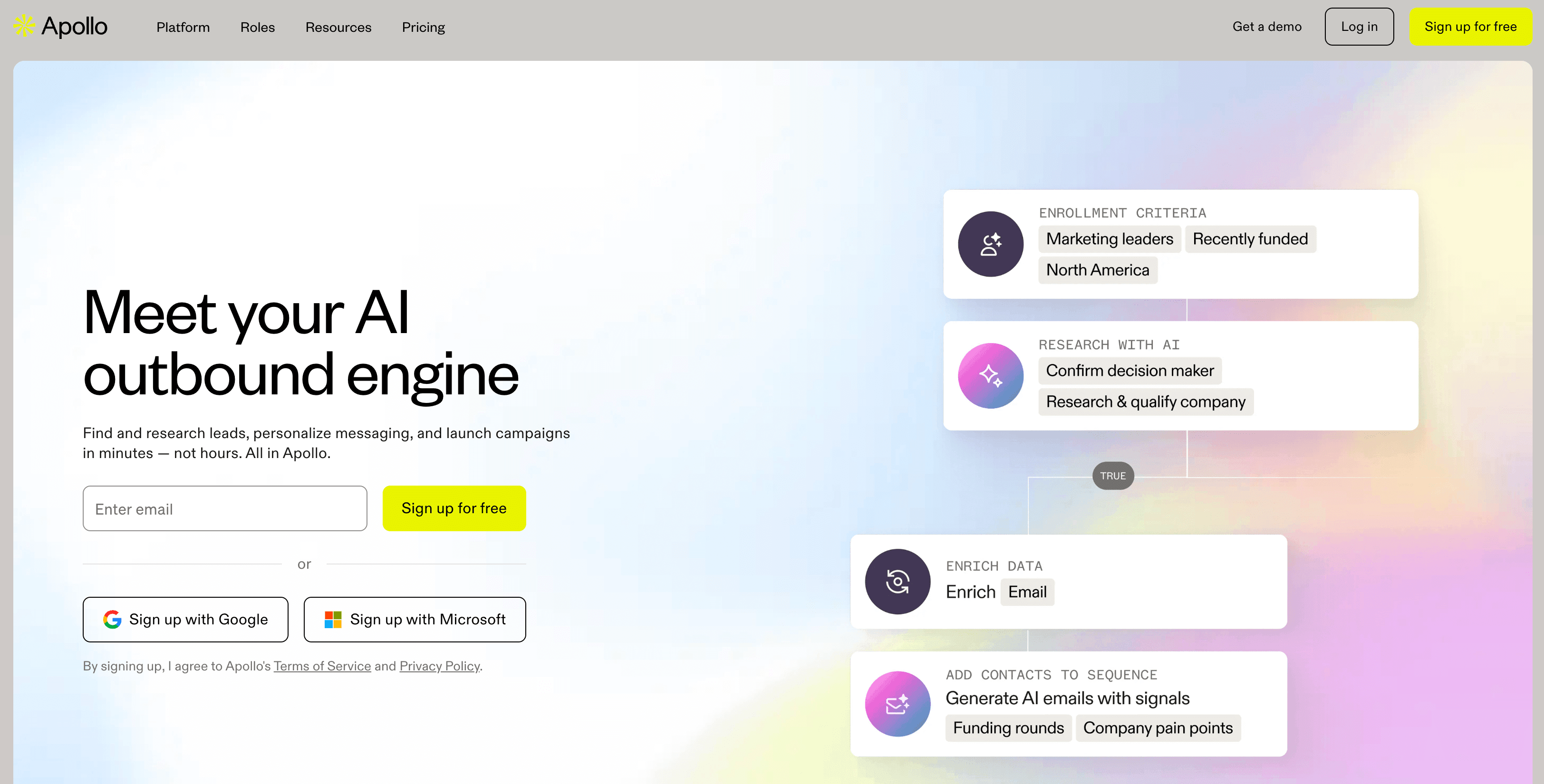
Key features:
- Advanced filtering (65+ criteria) for targeted lists
- Automated email sequences and call dialer
- Chrome extension for LinkedIn prospecting
- CRM integrations (Salesforce, HubSpot, etc.)
- AI-powered email writing and search
Strengths: Combines data enrichment and outreach in one tool. Frequent CRM data updates keep your leads fresh. Affordable compared to some legacy data providers.
Cons: Learning curve for advanced workflows. Email deliverability needs monitoring. Pricing is per user, which can add up for large teams.
Best for: B2B sales teams and SDRs prospecting at scale.
Pricing: Free tier (limited contacts); paid plans ~$49–$99/user/month.
Clay: Data Enrichment and Workflow Automation for Leads
Clay is like a supercharged, AI-powered spreadsheet for building custom lead enrichment workflows. If you’re the kind of person who loves tinkering with data and automations, Clay is your playground.
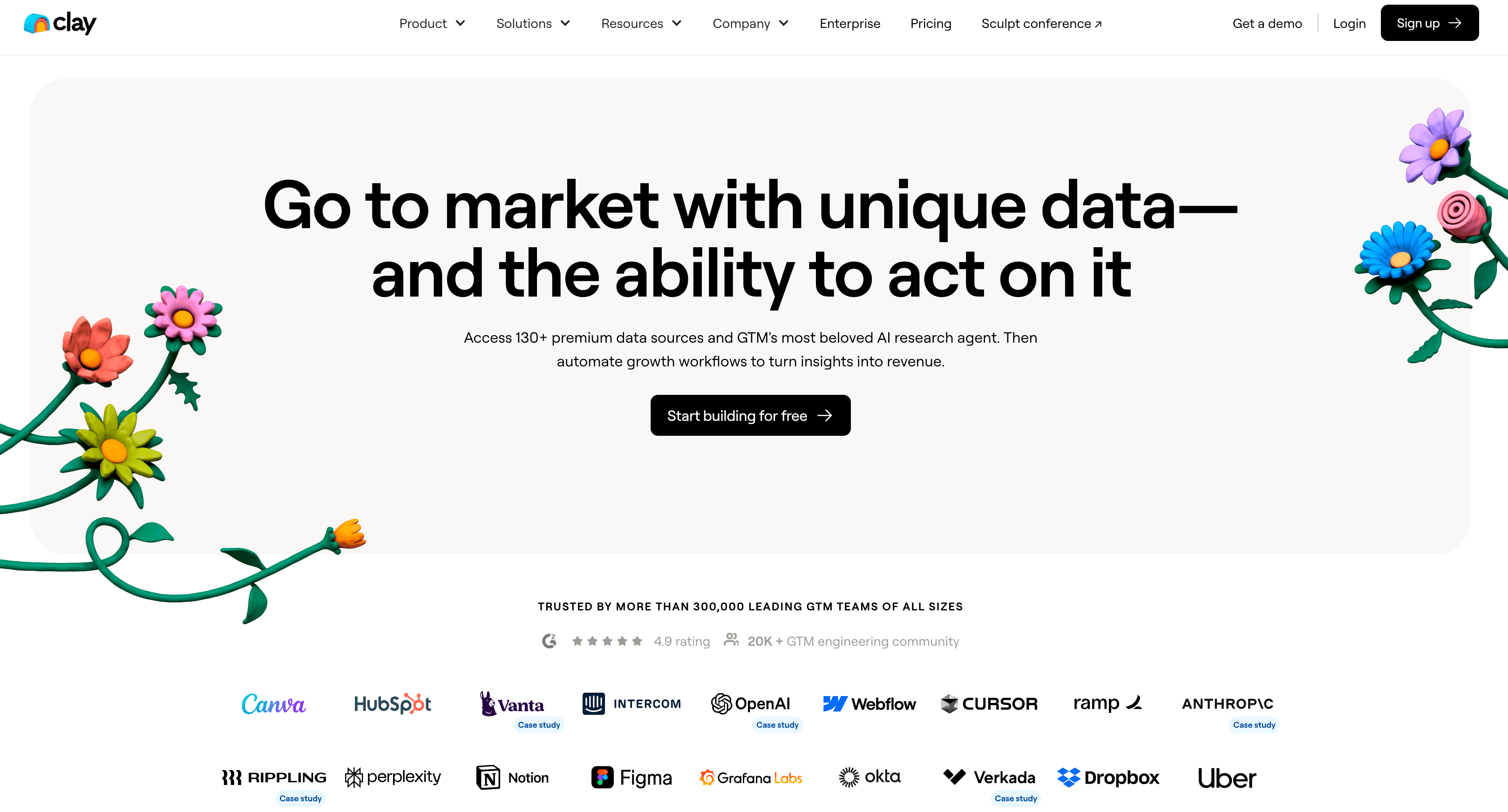
Key features:
- Connects to 50+ data sources (Apollo, Clearbit, LinkedIn, etc.)
- Spreadsheet-like interface for building custom automations
- GPT-4 integration for personalized messaging
- Real-time data enrichment and workflow triggers
Strengths: Insanely flexible—build multi-step enrichment pipelines, pull from multiple sources, trigger actions (like sending to CRM or email). Great for ops/growth teams who want to automate every step of lead research.
Cons: Credit-based pricing (can get expensive if not optimized). Setup requires some technical savvy. Not a standalone CRM or sequencer.
Best for: Tech-savvy sales ops or growth teams needing deep data enrichment.
Pricing: Free (100 credits); paid from $149/month.
Salesforce: Enterprise-Grade Lead Generation Automation
Salesforce is the gold standard for enterprise CRM and lead management. While it’s not a lead gen tool out-of-the-box, it’s the backbone for automating lead capture, scoring, and handoff at scale.
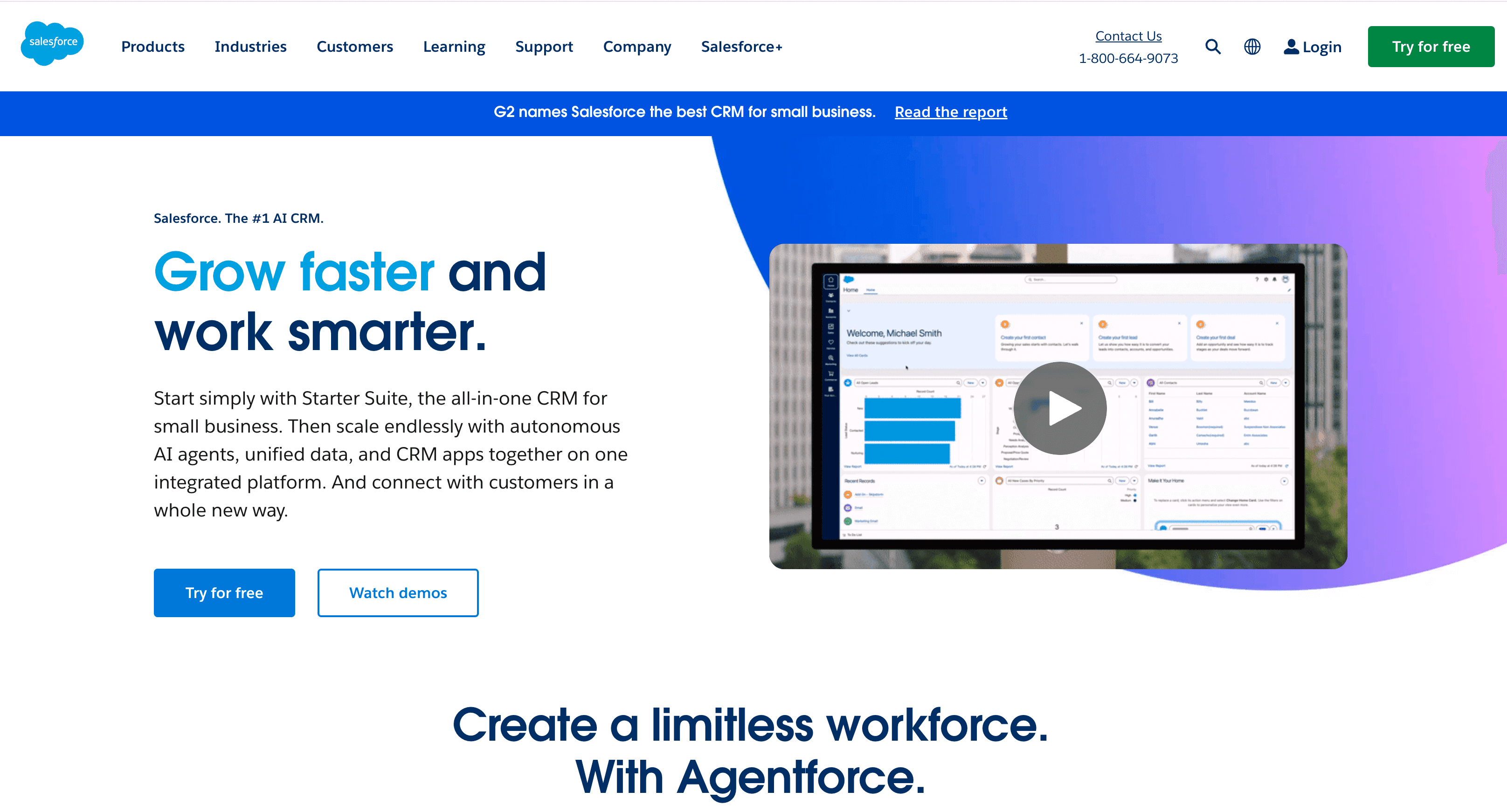
Key features:
- Lead and opportunity tracking
- Automation via Flow and Process Builder
- Einstein AI for lead scoring and forecasting
- Massive AppExchange ecosystem for add-ons
Strengths: Customizable for complex workflows, strong reporting, scales to thousands of users.
Cons: High cost and complexity, usually needs dedicated admins. Out-of-the-box, focuses on CRM; marketing automation often requires add-ons.
Best for: Large B2B organizations with complex sales processes.
Pricing: Starts ~$25–$75/user/month; typical deployments (with Marketing Cloud) run higher.
Wisepops: Onsite Lead Capture and Personalization
Wisepops specializes in turning your website traffic into leads with targeted pop-ups, banners, and forms.
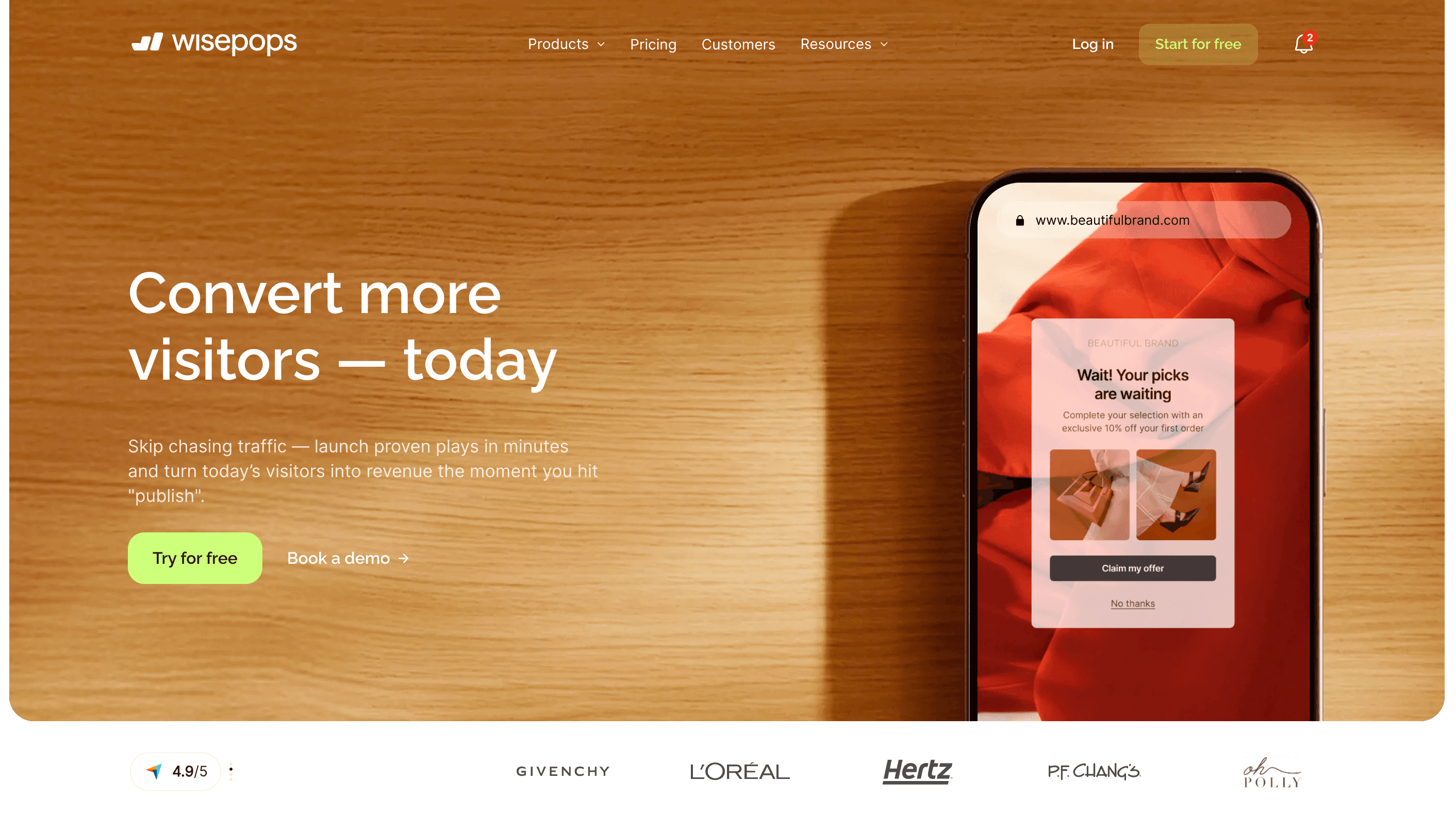
Key features:
- Drag-and-drop pop-up and form builder
- Advanced targeting (exit intent, scroll %, geo, etc.)
- A/B testing and analytics
- Integrates with email/CRM tools
Strengths: Highly customizable, great for e-commerce and B2B marketing teams wanting to boost onsite conversions.
Cons: Focused on onsite capture (not off-site lead gen). Entry price ($99/mo) may be steep for small sites.
Best for: E-commerce and B2B teams optimizing web conversions.
Pricing: $99/month (Pro 100k plan).
Unbounce: Automated Landing Pages for Lead Generation
Unbounce lets marketers build and optimize landing pages that convert—without waiting on developers.
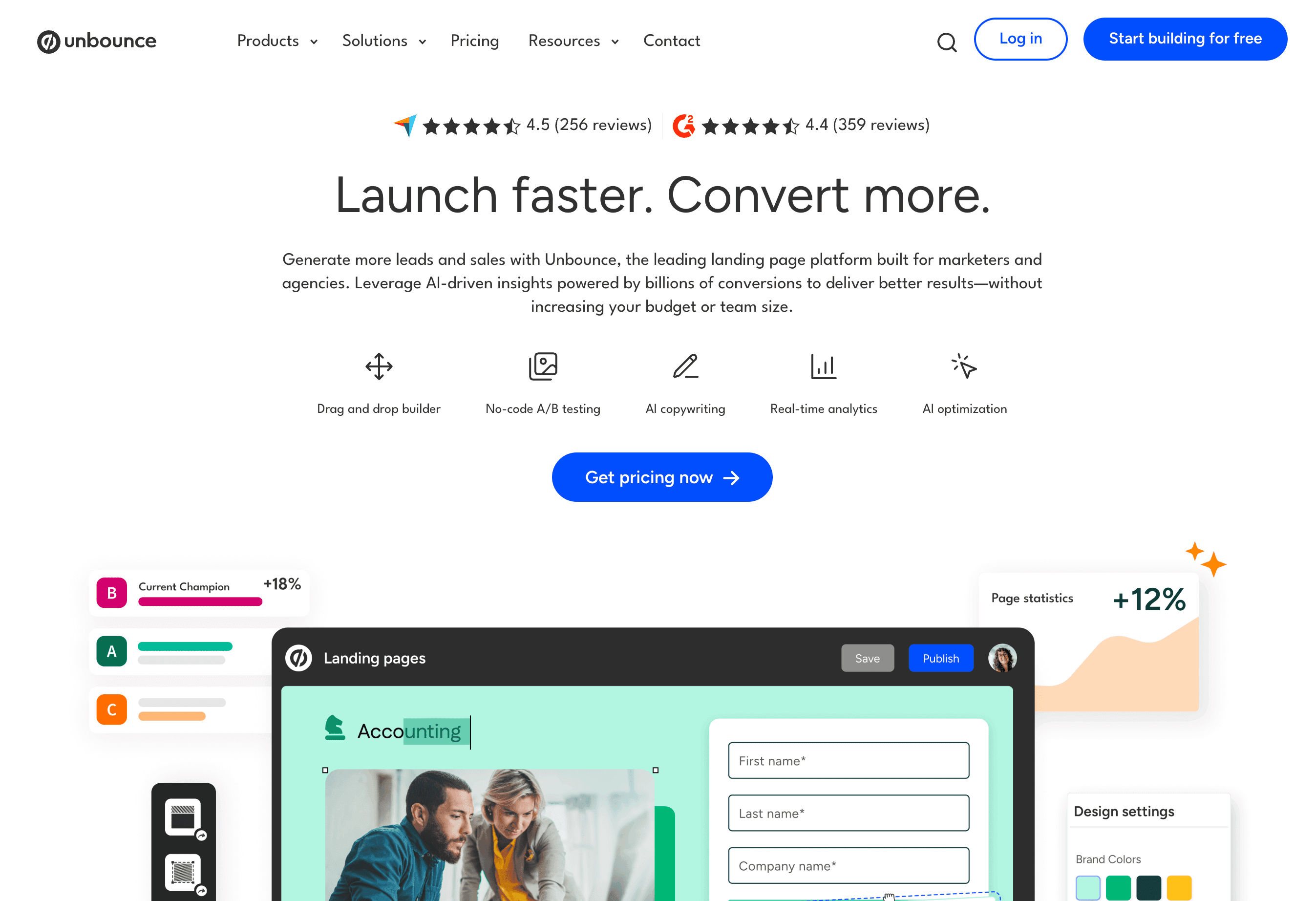
Key features:
- 100+ high-converting templates
- Drag-and-drop editor
- AI-powered copy assistant
- Smart Traffic (AI-driven variant routing)
- Built-in A/B testing and analytics
Strengths: Marketer-friendly, conversion-focused, integrates with CRM/email tools.
Cons: Higher price point ($80/mo+), design flexibility can be tricky for pixel-perfection.
Best for: Marketers running PPC, social, or email campaigns who need custom landing pages.
Pricing: $80/month (Launch plan).
OptinMonster: Automated Popups and Lead Forms
OptinMonster is a favorite for creating pop-ups, slide-ins, and lead forms—especially on WordPress sites.
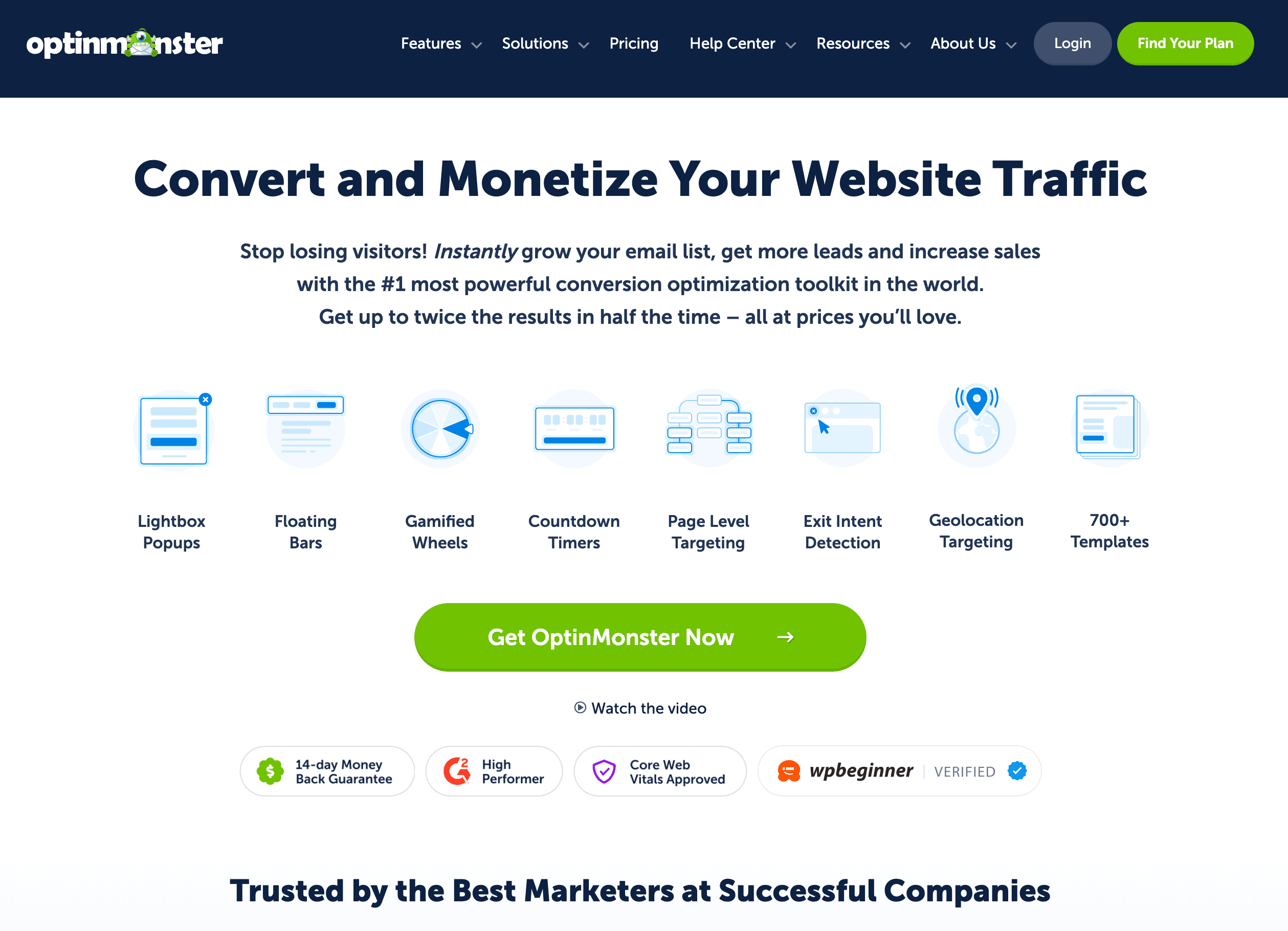
Key features:
- Variety of opt-in campaigns (pop-ups, bars, slide-ins)
- Behavioral targeting and exit-intent detection
- A/B testing and analytics
- Integrates with major email/CRM tools
Strengths: User-friendly, strong targeting, affordable for small businesses.
Cons: Not an email sender (needs integration). Advanced features in higher plans.
Best for: SMBs and bloggers growing email lists or capturing leads on their website.
Pricing: $19/month (Basic plan).
Marketo: Advanced Marketing Automation for Lead Nurturing
Marketo (now Adobe Marketo Engage) is the powerhouse for enterprise-level marketing automation and lead nurturing.
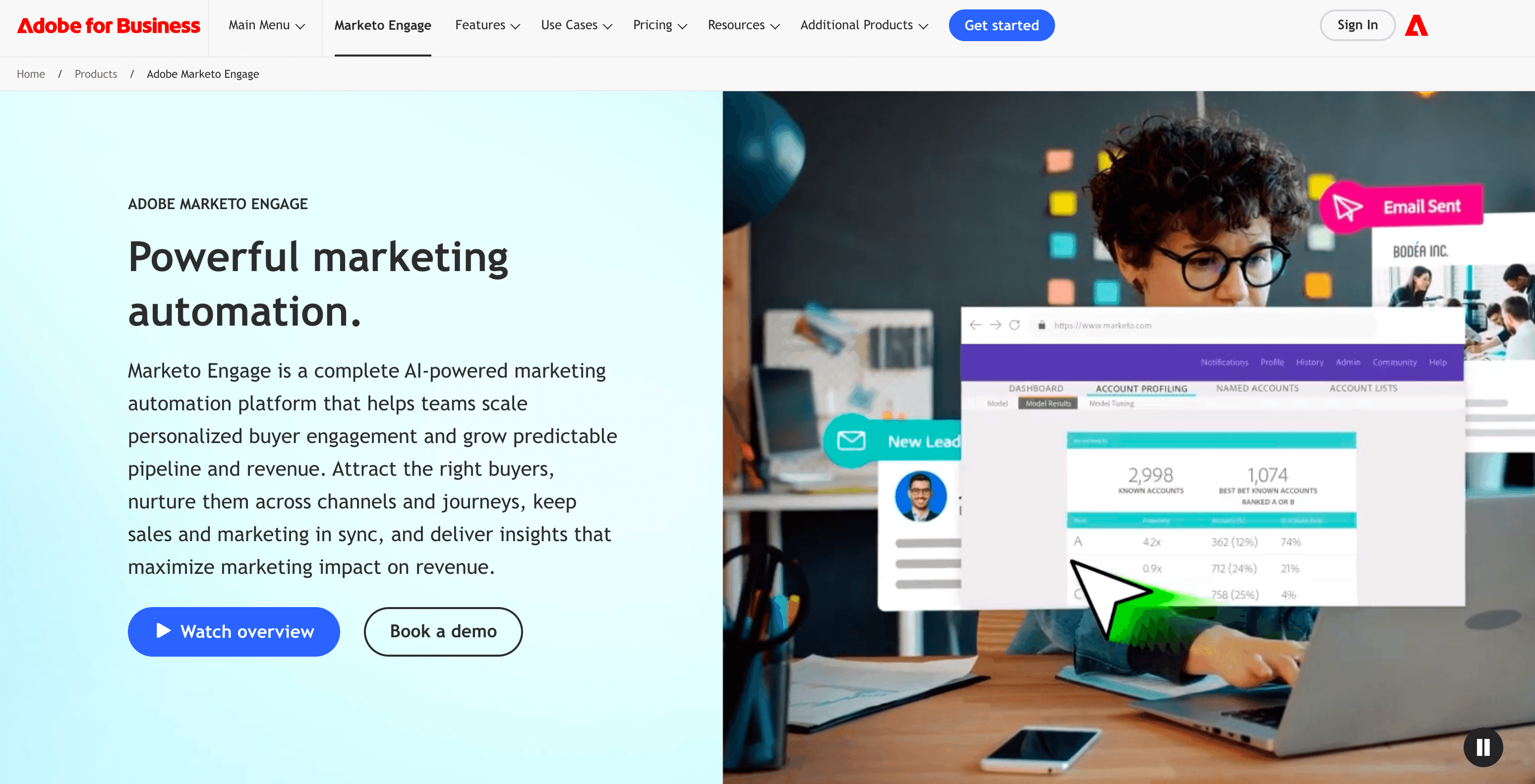
Key features:
- Sophisticated lead scoring and segmentation
- Multi-channel campaigns (email, web, ads)
- Personalization and trigger-based workflows
- Deep Salesforce integration
Strengths: Extremely powerful for complex lead management and nurturing.
Cons: Steep learning curve, expensive, UI feels dated.
Best for: Enterprise/B2B marketers managing long sales cycles.
Pricing: Custom (often $1k+/month).
Klaviyo: Automated Email and SMS Lead Nurturing
Klaviyo is the go-to for e-commerce brands wanting to maximize customer lifetime value with personalized email and SMS automation.
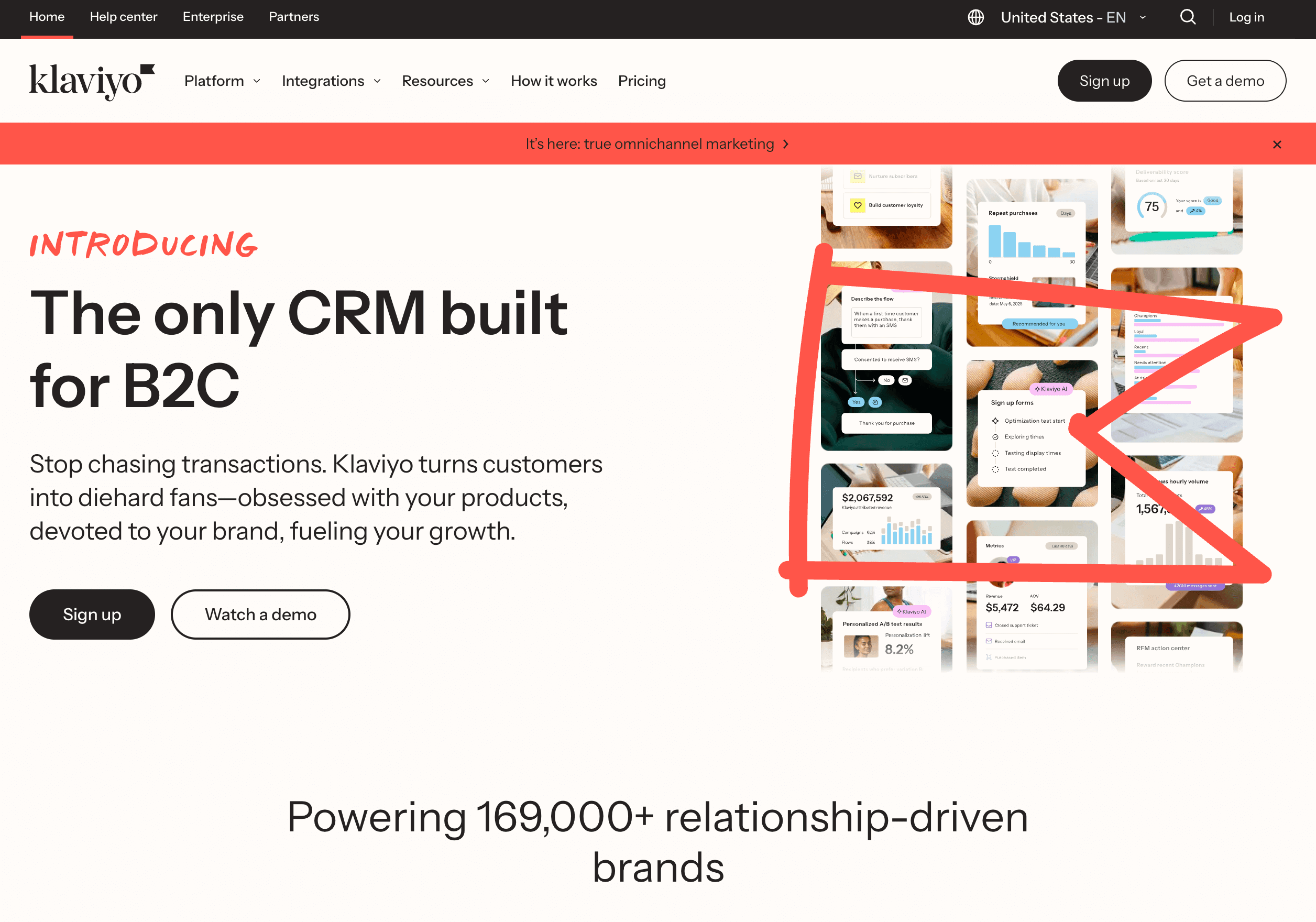
Key features:
- Deep Shopify/BigCommerce integration
- Pre-built flows (cart abandonment, welcome, win-back)
- Powerful segmentation and predictive analytics
- Revenue attribution
Strengths: Best-in-class for e-commerce, real-time segmentation, combines email/SMS.
Cons: Pricing rises quickly with list size, e-commerce focus.
Best for: Online stores and DTC brands.
Pricing: Free up to 250 contacts, then $110/mo (5k contacts).
Mailchimp: User-Friendly Email Automation for Lead Generation
Mailchimp is the classic all-in-one email marketing platform for small businesses and content creators.
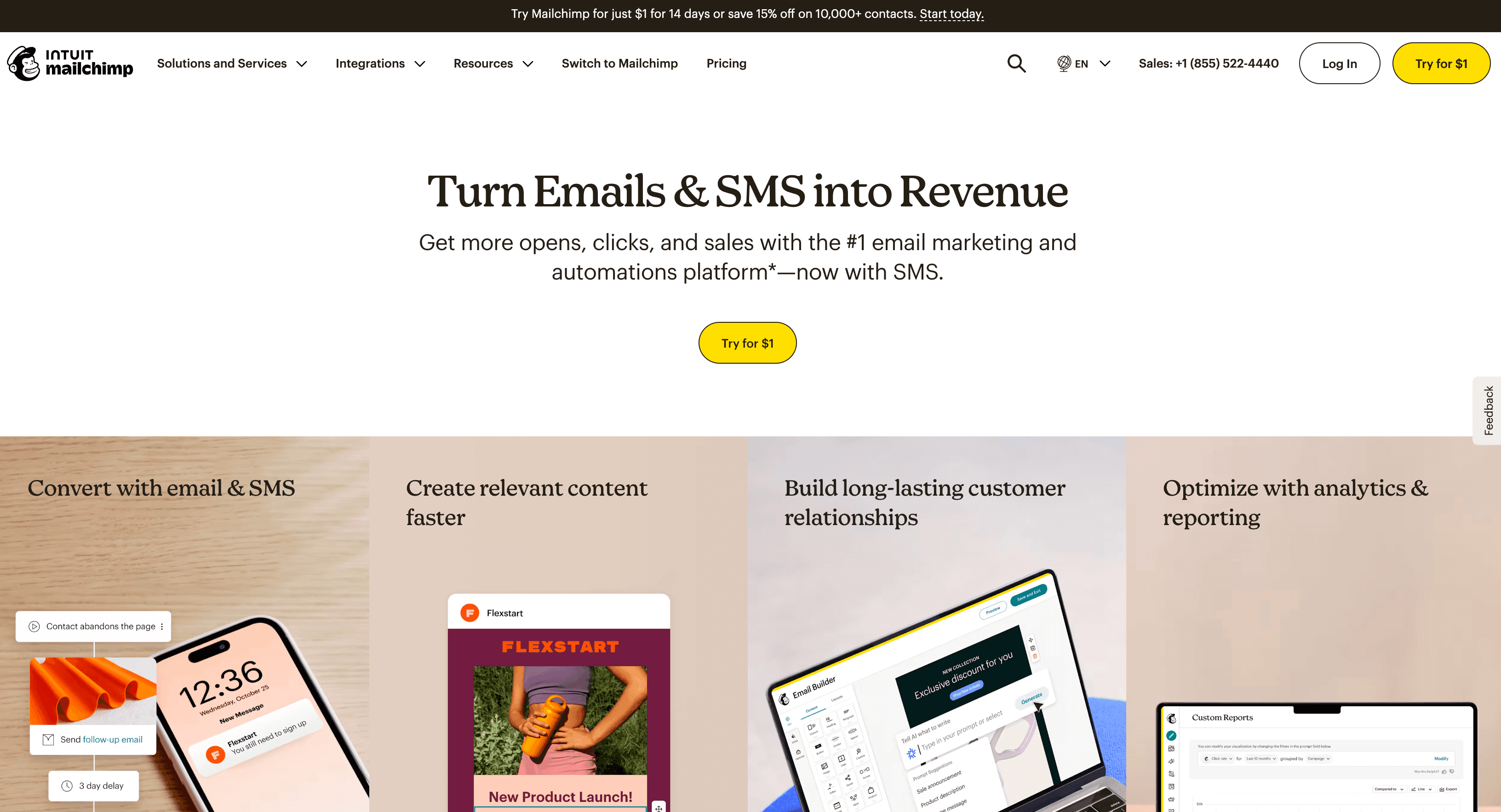
Key features:
- Drag-and-drop email builder
- Forms and basic landing pages
- Simple automation (welcome, drip)
- CRM-lite audience management
Strengths: Intuitive, generous free plan, great for beginners.
Cons: Limited advanced automation, price jumps with list size.
Best for: Small businesses, startups, and creators launching newsletters or simple drips.
Pricing: Free (500 contacts), paid from $13/month.
ActiveCampaign: Personalized Automation for Leads
ActiveCampaign is a favorite for SMBs needing advanced email/SMS automation and a built-in CRM.
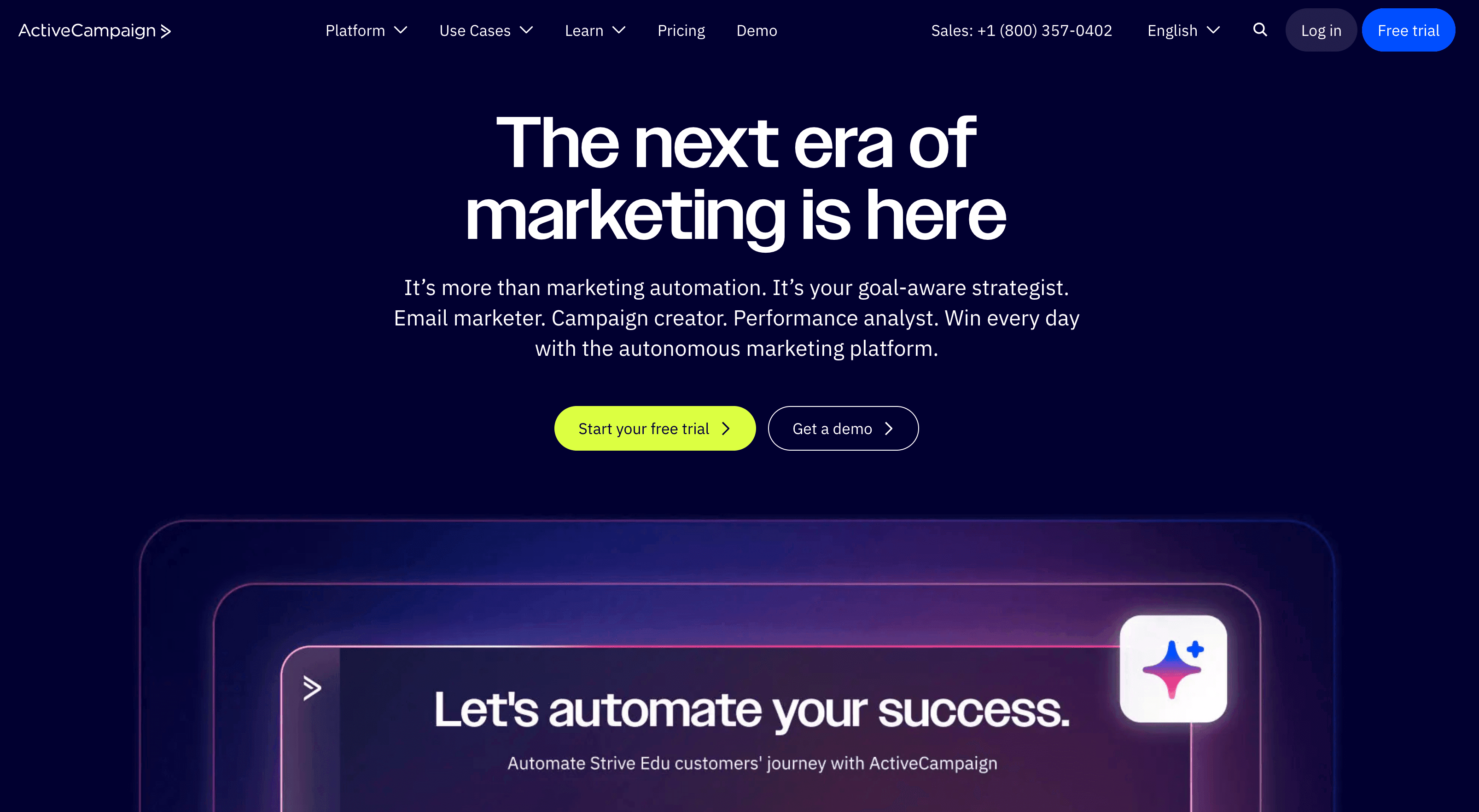
Key features:
- Visual automation builder (unlimited branches)
- Lead scoring and dynamic content
- CRM and sales automation
- 900+ integrations
Strengths: Powerful automation at a good value, highly personalized campaigns.
Cons: CRM is basic for big teams, pricing can get complex with add-ons.
Best for: Growing businesses needing advanced marketing/sales automation.
Pricing: $29/month (1,000 contacts).
Sprout Social: Social Media Automation for Lead Generation
Sprout Social helps brands automate social media publishing, engagement, and listening—turning social conversations into leads.
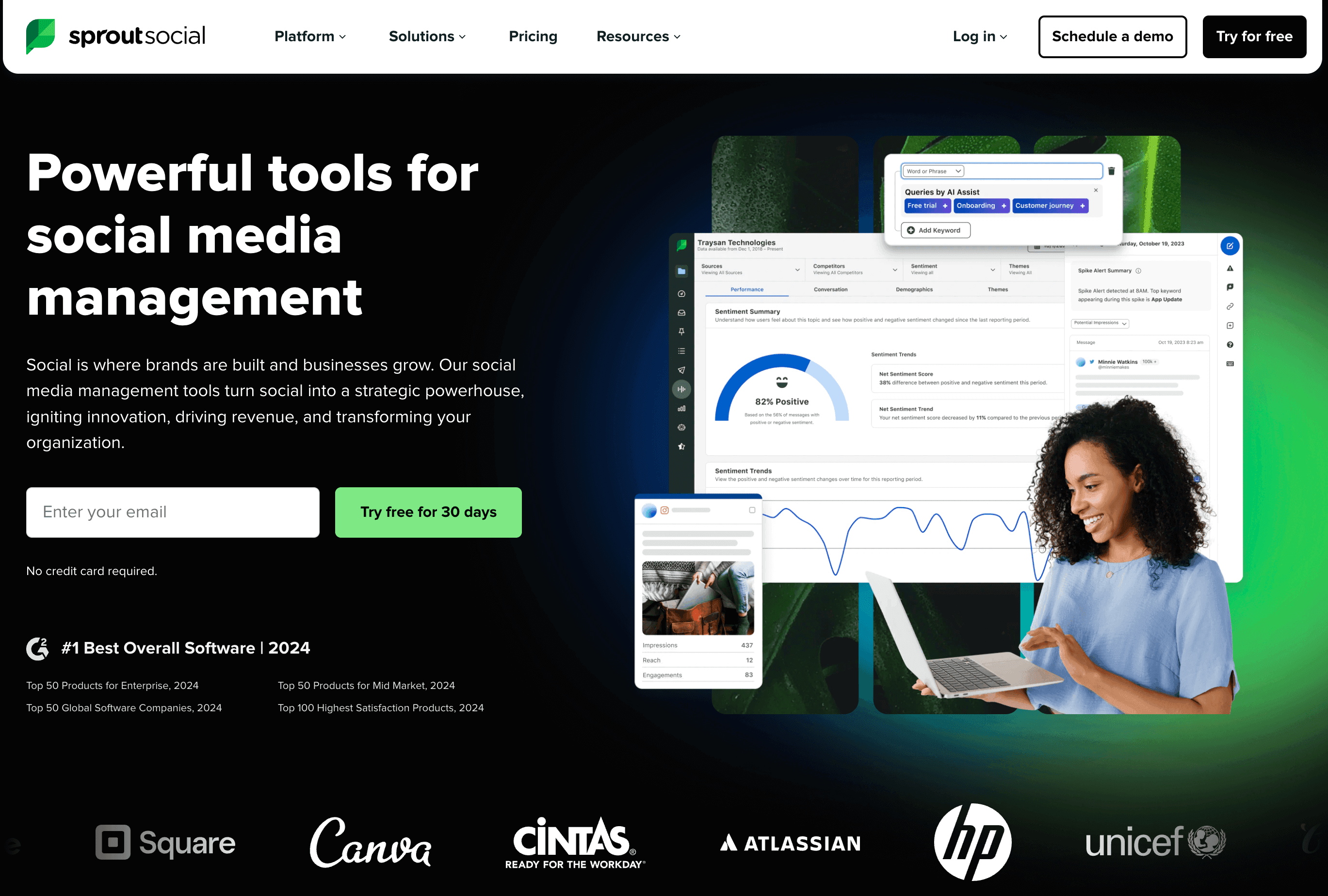
Key features:
- Unified inbox for all social channels
- Social listening for brand/keyword mentions
- AI chatbots for certain networks
- Analytics and reporting
Strengths: Efficient engagement, strong analytics, surfaces social leads in real time.
Cons: Not direct lead capture, higher price point, some channel/API limitations.
Best for: Social/community managers, brands with active social presence.
Pricing: $99/month per user.
Leadfeeder: Automated Website Visitor Identification
Leadfeeder reveals which companies are visiting your website—even if they don’t fill out a form.
![]()
Key features:
- IP-to-company identification
- Visitor behavior analytics
- CRM integrations (Salesforce, HubSpot, etc.)
- Lead scoring and real-time alerts
Strengths: Turns anonymous traffic into actionable B2B leads, easy CRM sync.
Cons: IDs companies, not individuals; depends on web traffic volume.
Best for: B2B SaaS/services, ABM teams wanting to leverage website visits.
Pricing: $55/month (Starter).
Drift: Conversational Automation for Lead Capture
Drift is the leader in conversational marketing—using chatbots to engage, qualify, and route leads in real time.
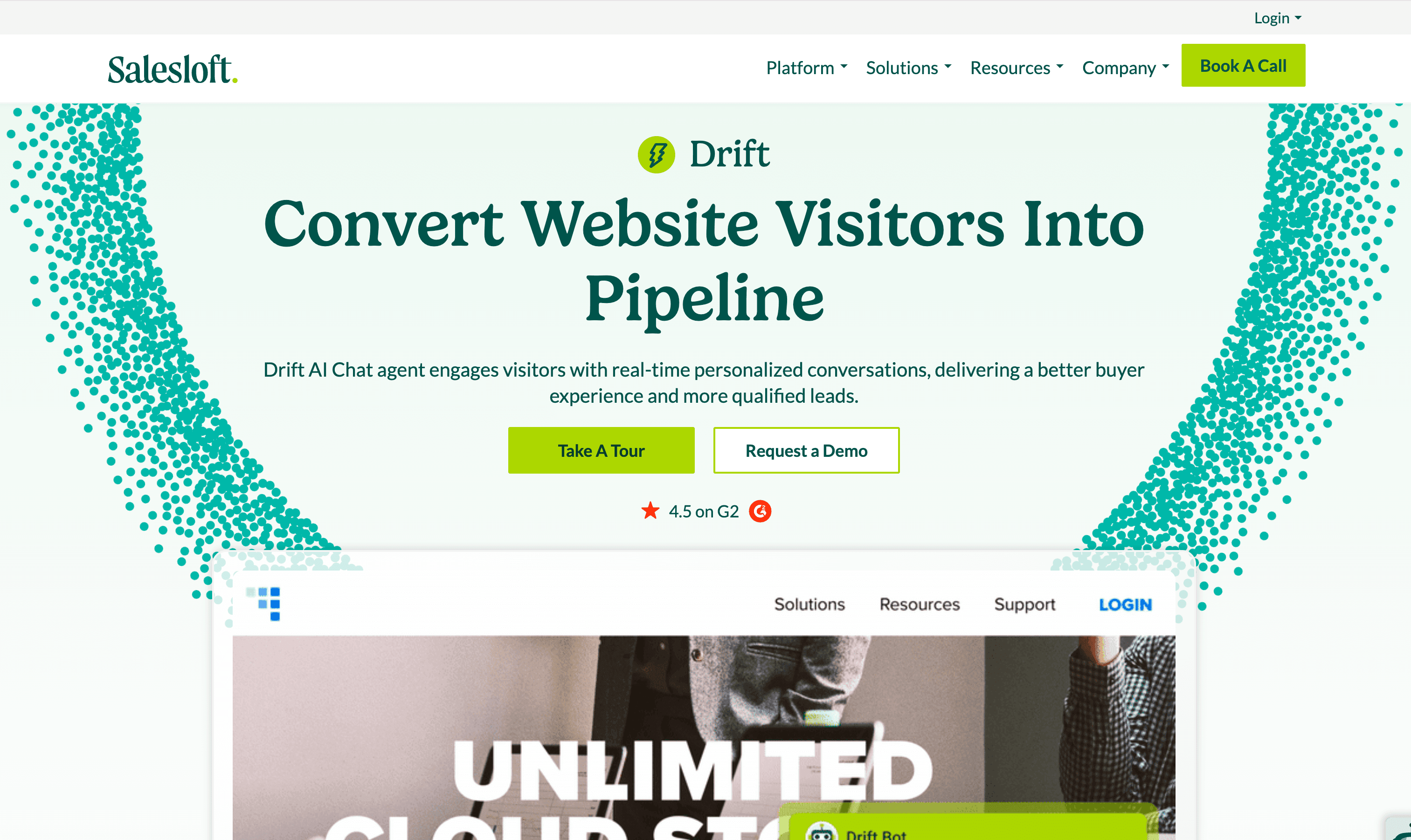
Key features:
- AI/rule-based chatbots with playbooks
- Automated meeting booking and lead routing
- Personalization for ABM (account-based marketing)
- Analytics and CRM integration
Strengths: Boosts engagement, qualifies leads 24/7, shortens sales cycles.
Cons: Works best with significant traffic, setup/maintenance needed, premium pricing.
Best for: B2B SaaS, ABM, high-traffic sites wanting to maximize web conversions.
Pricing: Free basic chat, paid from $50/month.
Which Automated Lead Generation Software Is Right for You?
Choosing the right tool is all about fit. Here’s how I’d break it down:
- For non-technical users scraping web leads: is the easiest way to turn any website into a lead list—especially if you want AI web scraping without the hassle.
- For all-in-one CRM and marketing automation: HubSpot is the go-to for teams wanting everything in one place.
- For B2B outbound prospecting at scale: Apollo.io gives you a massive contact database and built-in outreach.
- For custom data enrichment workflows: Clay is ideal for ops/growth teams who want to build their own enrichment pipelines.
- For enterprise lead management: Salesforce and Marketo are the heavyweights, but require more resources.
- For e-commerce lead nurturing: Klaviyo is purpose-built for online stores.
- For website conversion optimization: Wisepops, Unbounce, and OptinMonster help you capture more leads from your existing traffic.
- For social-driven lead gen: Sprout Social keeps you on top of social conversations that can turn into leads.
- For identifying anonymous B2B visitors: Leadfeeder is a secret weapon for ABM teams.
- For conversational lead capture: Drift turns your website into a 24/7 sales assistant.
If you’re just starting out, try a couple of free trials (Thunderbit, Mailchimp, Apollo, etc.) and see which fits your workflow and team best. If you’re scaling fast or have complex needs, look for tools that integrate well with your CRM and marketing stack.
Conclusion: Boost Your Lead Generation with Automation
Automated lead generation software is no longer a luxury—it’s a necessity for any team that wants to scale efficiently and outpace the competition. By automating the repetitive, error-prone parts of lead gen, you free up your team to focus on what really matters: building relationships and closing deals.
- More leads, better leads, less manual work: Automation lets you capture, qualify, and nurture leads at scale, with higher accuracy and faster response times.
- AI web scrapers like Thunderbit make it possible to turn any website into a structured lead list in minutes—no coding, no headaches.
- Integrated platforms like HubSpot, Apollo, and ActiveCampaign ensure your leads are nurtured and handed off to sales at the right moment.
My advice? Map your lead generation journey, identify your bottlenecks, and pick the tool (or combination of tools) that fits your business and team. And if you’re tired of copy-paste, give a spin—it’s the fastest way I know to go from “I found a great lead” to “I’m ready to reach out.”
Ready to supercharge your pipeline? Start automating your lead generation today—and let the software do the heavy lifting, so you can focus on closing more deals.
FAQs
1. What is automated lead generation software and why is it important?
Automated lead generation software streamlines the process of finding, capturing, and nurturing leads using tools like AI and web scraping. It saves time, increases accuracy, boosts lead volume, and helps teams focus on selling rather than manual data entry.
2. Which tool is best for non-technical users who want to scrape websites for leads?
Thunderbit is ideal for non-technical users. With a Chrome extension and AI-assisted scraping, it allows users to extract data from any website in just two clicks—no coding required.
3. How do I choose the right lead generation tool for my business?
Start by identifying your team's needs—whether it’s scraping web data, managing a CRM, running outbound outreach, or optimizing website conversions. Then match those needs to tools like Thunderbit, HubSpot, Apollo, or Clay based on features, pricing, and ease of use.
4. What are some of the top-rated automated lead generation tools for 2025?
Some of the top tools include Thunderbit (AI web scraping), HubSpot (all-in-one CRM and automation), (prospecting and outreach), Clay (custom data enrichment), and Salesforce (enterprise CRM automation).
5. Can automation really improve lead quality and conversion rates?
Yes. Teams using automation report up to 77% higher conversion rates and 451% more qualified leads. Automation ensures leads are consistently captured, enriched, and nurtured, reducing errors and maximizing sales efficiency.
Learn More: